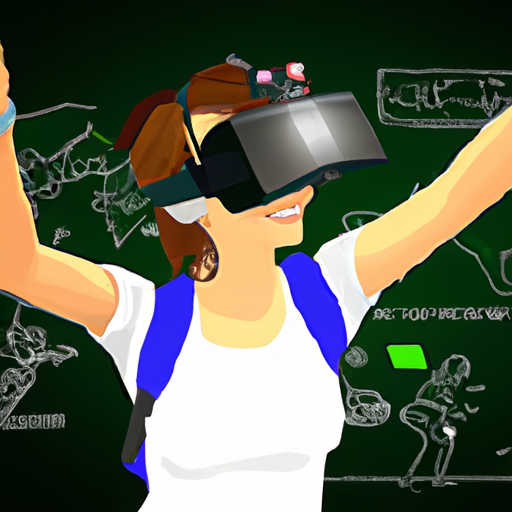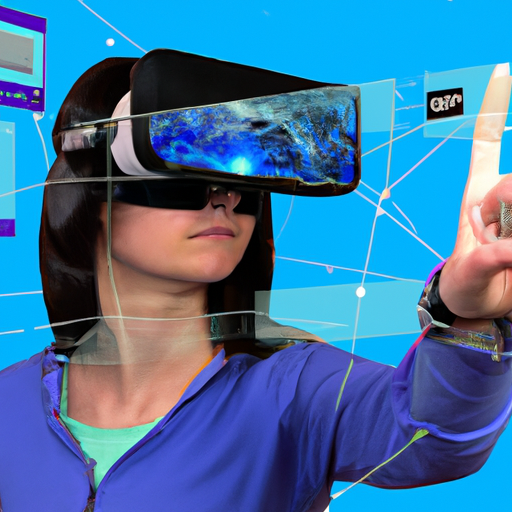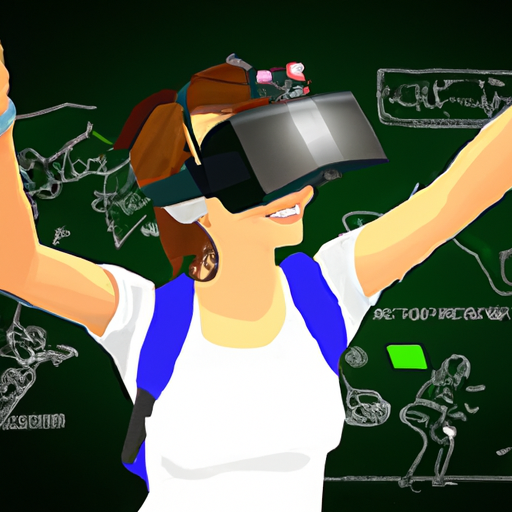Trends In Educational Technology
In the rapidly evolving world of education, staying updated on the latest trends in educational technology is crucial. As classrooms embrace digital tools and platforms, teachers and students are finding new and innovative ways to enhance learning. From interactive online learning experiences to virtual reality simulations, this article explores the current trends in educational technology that are revolutionizing classrooms worldwide. Get ready to explore the exciting possibilities and future of education in the digital age.
Table of Contents
Online Learning
Virtual Classrooms
Virtual classrooms are online platforms that simulate traditional classrooms, allowing students and teachers to interact virtually in real-time. Through video conferencing, shared whiteboards, and chat features, virtual classrooms enable seamless communication and collaboration. You can participate in discussions, ask questions, and even work on group projects just like you would in a physical classroom. With the flexibility and convenience of virtual classrooms, you have the opportunity to engage in meaningful learning experiences from the comfort of your own home.
MOOCs (Massive Open Online Courses)
MOOCs, or Massive Open Online Courses, have revolutionized the accessibility of education. These online platforms offer a wide range of courses from universities and institutions around the world. You can enroll in courses on various subjects, from computer programming to art history, at no cost. MOOCs provide high-quality educational content in the form of lectures, assignments, and assessments. Moreover, you have the flexibility to learn at your own pace and join discussions with a global community of learners.
Microlearning
Microlearning involves breaking down educational content into bite-sized modules or lessons that can be consumed in short bursts. It provides you with quick and easily digestible information, making it ideal for busy individuals or those with limited attention spans. Whether it’s through short videos, interactive quizzes, or infographics, microlearning presents knowledge in a concise and engaging manner. This approach allows you to learn efficiently, focus on specific topics of interest, and retain information effectively.
Gamification in Online Learning
Gamification incorporates elements of game design into educational activities and materials to enhance engagement and motivation. By applying game mechanics such as points, badges, levels, and leaderboards to learning experiences, gamification makes education more interactive and enjoyable. Online learning platforms often utilize gamification techniques to encourage progress and reward achievements. Through quests, challenges, and virtual competitions, you can immerse yourself in educational games that promote active learning and foster a sense of accomplishment.
Mobile Learning
Mobile learning, also known as m-learning, leverages the ubiquity of mobile devices such as smartphones and tablets to deliver educational content anytime, anywhere. With the help of educational apps, you can access lectures, videos, quizzes, and other resources on-the-go. Mobile learning platforms are designed to be intuitive, user-friendly, and responsive on smaller screens. This mode of learning allows you to personalize your education, adapt to your schedule, and make the most of your free time. Whether you are commuting or taking a break, mobile learning enables continuous learning opportunities.
Artificial Intelligence
Intelligent Tutoring Systems
Intelligent Tutoring Systems (ITS) use artificial intelligence to provide personalized guidance and support to learners. These systems analyze your performance, identify areas of improvement, and offer tailored feedback. ITS can adapt to your learning style, pace, and preferences, making the learning process more efficient and effective. With ITS, you can receive individualized instruction, practice essential skills, and receive immediate feedback to enhance your understanding and performance.
Automated Grading
Automated grading utilizes artificial intelligence algorithms to assess and evaluate assignments, quizzes, and exams. This technology eliminates the need for manual grading, saving teachers time and allowing for faster feedback. Through machine learning algorithms, the system learns from previous grading patterns to improve accuracy and consistency. Automated grading systems provide objective evaluations, reduce bias, and ensure timely feedback, promoting efficiency and fairness in the assessment process.
Personalized Learning
Personalized learning leverages artificial intelligence to create customized learning experiences tailored to your individual needs and learning style. By analyzing your strengths, weaknesses, and preferences, adaptive learning systems can generate personalized learning pathways. These pathways deliver content and activities that align with your current knowledge and skills, allowing you to progress at your own pace. With personalized learning, you can focus on areas that require more attention, increasing overall learning efficiency and engagement.
Chatbots for Student Support
Chatbots are virtual assistants designed to provide automated responses and assistance to learners. Powered by artificial intelligence, chatbots can answer frequently asked questions, provide guidance, and support your learning journey. They can offer instant feedback, suggest resources, and help clarify concepts. Chatbots also ensure 24/7 availability, eliminating the need to wait for human responses. By incorporating chatbot technology in online learning platforms, you can have access to immediate support and personalized assistance whenever you need it.
Data-driven Decision-making
Data analytics and artificial intelligence enable educational institutions to make informed decisions about teaching and learning practices. By analyzing large volumes of data, such as student performance, engagement, and learning preferences, institutions can identify trends, patterns, and areas for improvement. This data-driven approach helps educators tailor their teaching strategies, develop personalized interventions, and optimize educational resources. By harnessing the power of artificial intelligence and data analytics, educational institutions can enhance the quality of education and ensure students’ success.

Virtual Reality
Immersive Educational Experiences
Virtual Reality (VR) creates immersive and interactive learning experiences by simulating real-world environments. With the help of VR headsets, you can explore virtual landscapes, historic sites, or even distant planets. VR immerses you in a three-dimensional environment, allowing for a deeper understanding and engagement with the subject matter. Whether you are studying history, biology, or art, virtual reality provides a unique and captivating way to learn by experiencing and interacting with content rather than passively consuming it.
Virtual Field Trips
Virtual field trips bring the world to your classroom or home, providing access to locations that may otherwise be impossible to visit physically. By using VR, you can virtually tour museums, historical sites, or natural wonders. With the guidance of experts, you can explore these places in detail and learn about their significance. Virtual field trips eliminate geographical constraints, allowing you to broaden your knowledge and perspective through firsthand experiences, even if you are miles away.
Virtual Labs
Virtual labs simulate laboratory environments, enabling you to conduct experiments and practice scientific techniques virtually. Through VR technology, you can manipulate virtual tools and equipment, conduct experiments, and observe realistic reactions. Virtual labs provide a safe and cost-effective alternative to traditional physical labs, offering endless possibilities for experimentation without the need for specialized equipment or hazardous materials. This immersive learning approach enhances scientific understanding and practical skills development.
Simulations for Skill-building
Simulations utilize virtual reality to replicate real-life scenarios for skill-building purposes. Whether it’s practicing medical procedures, flight simulations, or crisis management scenarios, virtual reality allows you to experience and learn from simulated events in a controlled environment. VR simulations provide hands-on training, allowing you to make mistakes, learn from them, and build practical expertise. This experiential learning approach enhances critical thinking, decision-making, and problem-solving skills in a safe and immersive environment.
360-degree Videos for Experiential Learning
360-degree videos offer a unique and immersive learning experience by capturing a panoramic view of real-life situations. These videos allow you to explore specific environments, industries, or situations from every angle. Whether you want to visit an archaeological site, observe wildlife, or witness important events, 360-degree videos provide a sense of presence and engagement. This perspective expands your understanding and connects you to different cultures, places, and experiences, enriching your overall learning journey.
Gamification
Game-based Learning
Game-based learning integrates educational content and objectives into interactive games. By gamifying learning activities, you can enhance engagement, motivation, and active participation. Whether it’s solving puzzles, completing quests, or earning points, game-based learning provides a playful and immersive environment where you can acquire knowledge and skills while having fun. Educational games foster critical thinking, problem-solving, collaboration, and other valuable skills, making the learning process enjoyable and effective.
Badges and Rewards
Badges and rewards are digital representations of achievements and progress in online learning environments. By earning badges, completing milestones, or accomplishing specific tasks, you can demonstrate your skills and knowledge in a visible and tangible way. Badges and rewards serve as incentives, recognizing your efforts and promoting a sense of accomplishment. They can also encourage healthy competition among learners, motivating you to push your boundaries and achieve higher levels of mastery.
Leaderboards and Competition
Leaderboards display the rankings and progress of learners in online learning platforms. By showcasing the achievements of individuals or groups, leaderboards instill a sense of competition and promote goal-oriented learning. Leaderboards provide a visual representation of your progress compared to others, spurring you to improve your performance and climb the rankings. Competition within a supportive learning community can foster motivation, engagement, and a drive to excel.
Quests and Challenges
Quests and challenges introduce elements of adventure and exploration into the learning process. By embarking on quests, you engage in a series of tasks or challenges that progressively build knowledge and skills. Quests and challenges create a narrative-driven learning experience, where you take on roles, solve problems, and achieve objectives. This gamified approach provides a sense of purpose, excitement, and accomplishment, transforming the learning journey into an immersive and rewarding adventure.
Social Interaction through Gaming
Gamification in online learning encourages social interaction and collaboration among learners. Through multiplayer games, discussion forums, or collaborative tasks, you can engage in meaningful interactions with peers from around the world. Gaming environments foster teamwork, communication skills, and peer-to-peer learning. By sharing strategies, solving problems together, and celebrating collective achievements, you build social connections and a sense of community within the online learning environment.

Augmented Reality
Interactive Textbooks
Interactive textbooks infused with augmented reality enhance the traditional reading experience by bringing content to life. By using an AR-enabled device, you can scan the pages of a textbook and unlock additional multimedia content such as videos, 3D models, or interactive simulations. This interactive content deepens your understanding, engages your senses, and provides a more comprehensive learning experience. Interactive textbooks bridge the gap between static text and dynamic visuals, making learning more engaging and immersive.
AR-enhanced Learning Materials
Augmented reality enhances learning materials by overlaying digital elements onto the physical world. Whether it’s markers, posters, or even everyday objects, AR allows you to interact with additional content through your device’s camera. For example, you can view 3D models of scientific concepts, manipulate virtual objects, or perform virtual experiments using AR-enhanced learning materials. By merging the physical and digital realms, augmented reality adds a new layer of interactivity, visualization, and engagement to your learning experience.
Virtual Models and Simulations
Augmented reality enables you to explore virtual models and simulations in a more interactive and realistic way. By overlaying digital elements onto the physical world, you can interact with and manipulate virtual objects, structures, or organisms. AR simulations provide a hands-on and immersive learning experience, allowing you to experiment, make observations, and draw conclusions. Whether you are studying the human body, architectural designs, or chemical reactions, virtual models and simulations in augmented reality offer a dynamic and engaging approach to learning.
AR for Real-time Feedback
Augmented reality can provide real-time feedback on your performance or actions. For example, AR can overlay coaching instructions, annotations, or suggestions on your physical movements or techniques. This immediate feedback allows you to make adjustments, correct errors, and improve your skills in real-time. Whether you are practicing a sport, learning a musical instrument, or perfecting a particular technique, AR-based feedback enhances your learning process and accelerates skill development by providing timely guidance.
Enhanced Storytelling
Augmented reality enhances storytelling by transforming narratives into immersive experiences. By using AR-enabled devices, you can explore stories that come to life with visuals, sounds, and interactive elements. AR storytelling engages your imagination and transports you to different worlds and time periods. For instance, you can walk side-by-side with historical figures, witness pivotal events, or delve into the imaginary realms of literature. Augmented reality adds a new dimension to storytelling, sparking curiosity, and sparking your creativity.
Data Analytics
Learning Analytics
Learning analytics involves analyzing educational data to gain insights into the learning process. By collecting and examining data related to student performance, engagement, and behavior, educators and institutions can identify patterns, trends, and areas for improvement. Learning analytics provide valuable information that can inform instructional decisions, curriculum design, and student support interventions. By leveraging learning analytics, educators can optimize teaching strategies, identify at-risk students, and personalize learning experiences to enhance student outcomes.
Predictive Analysis for Personalized Education
Predictive analysis utilizes data and algorithms to anticipate future events or behaviors. In education, predictive analysis can forecast students’ performance, identify potential challenges, and offer personalized interventions. By analyzing historical data and learning patterns, predictive analysis models can estimate the likelihood of success or failure, enabling educators to tailor their support based on individual needs. Predictive analysis empowers educators to be proactive rather than reactive, fostering personalized education and increasing the chances of student success.
Assessment and Feedback Improvement
Data analytics can improve the assessment and feedback process, making it more accurate, efficient, and informative. By analyzing assessment data, educators can identify patterns, trends, or biases that could influence grading decisions. Data-driven analysis ensures objectivity, fairness, and consistency in the evaluation of student work. Through automated feedback systems, educators can provide timely and tailored feedback to students, facilitating their learning and growth. Data analytics enhances the assessment and feedback loop, ensuring meaningful and actionable feedback for students.
Early Identification of At-Risk Students
Data analytics can help identify students who may be at risk of underperforming or facing specific challenges. By monitoring various indicators such as attendance, grades, or engagement, institutions can detect early warning signs and provide timely interventions. Data-driven early identification systems enable educators to offer targeted support, resources, or personalized interventions to at-risk students. Early intervention ensures that students receive the assistance they need to overcome obstacles, achieve their potential, and succeed academically.
Customized Learning Pathways
Data analytics enables the creation of customized learning pathways tailored to individual students’ needs and goals. By analyzing learning data, such as assessment results, preferences, or progress, educators can adapt instructional strategies and content delivery. Customized learning pathways offer personalized learning experiences, allowing students to focus on areas of interest or areas that require further development. This data-driven approach ensures that students receive content and activities that align with their abilities, fostering engagement, motivation, and better learning outcomes.
Open Educational Resources
Free Textbooks and Educational Materials
Open Educational Resources (OER) provide free and openly licensed educational materials that can be freely used, shared, and modified. OER include textbooks, lecture notes, multimedia resources, and other learning materials. By utilizing OER, you can access high-quality educational content without financial barriers. Open textbooks, for example, offer cost-effective alternatives to traditional textbooks, alleviating the burden of expensive educational resources. OER foster collaboration, open access, and democratize education, making quality learning materials available to learners worldwide.
Open Access Journals
Open access journals promote the free and unrestricted availability of scholarly research to the public. By providing free access to research articles, studies, and scientific publications, open access journals eliminate subscription fees and barriers to knowledge. Researchers, students, and educators can access the latest findings and advancements in their fields without paywalls or restrictions. Open access journals facilitate the dissemination of knowledge, collaboration, and innovation in academia, driving progress and accelerating discovery.
Open Courseware
Open courseware refers to educational courses or learning materials that are made freely available online. Open courseware platforms provide access to course syllabi, lecture notes, assignments, and other resources. By accessing open courseware, you can learn from prestigious institutions and renowned educators without formal enrollment or tuition fees. Open courseware platforms offer a wide range of subjects and disciplines, democratizing education and providing opportunities for lifelong learning and professional development.
Collaborative Online Projects
Collaborative online projects allow learners from different locations to work together on shared projects or tasks. Online platforms facilitate collaboration, communication, and file sharing, enabling learners to collaborate synchronously or asynchronously. Collaborative online projects foster teamwork, critical thinking, problem-solving, and communication skills. By engaging in collaborative projects, you develop valuable competencies, learn from diverse perspectives, and form connections with peers around the world. Collaborative online projects promote active learning, cooperation, and cross-cultural understanding.
Open Source Software
Open source software refers to software whose source code is available to the public, allowing users to view, modify, and distribute it freely. In education, open source software provides cost-effective alternatives to proprietary software. Whether it’s learning management systems, productivity tools, or programming software, open source solutions offer flexibility, customization options, and community-driven support. Open source software fosters innovation, collaboration, and empowers educators and learners to adapt tools to their specific needs.
Blockchain
Secure Student Records
Blockchain technology ensures the security, authenticity, and permanence of student records. By storing academic achievements, courses, and certifications on a decentralized and tamper-proof ledger, blockchain provides transparency and integrity to student records. Blockchain-based records are resistant to fraud, hacking, or unauthorized modification, as each transaction is verified and recorded by multiple participants. With blockchain, you can have complete ownership and control over your educational achievements, enabling reliable verification and trust in your credentials.
Verifiable Digital Credentials
Blockchain technology enables the issuance and verification of digital credentials, such as badges, certificates, or diplomas. By leveraging blockchain’s immutability and cryptographic properties, digital credentials become tamper-proof and verifiable in real-time. Each credential is associated with a unique identifier and can be independently verified by employers, institutions, or other parties. Blockchain-based digital credentials streamline the verification process, eliminate fraudulent activities, and enhance the trustworthiness of your qualifications in today’s digital world.
Transparent Certification Processes
Blockchain enhances the transparency of certification processes by providing a decentralized and auditable framework. With blockchain, the entire certification process, from the issuance to the verification of certificates, is recorded on a public ledger. This transparency ensures that certifications are valid, authentic, and based on verified criteria. Blockchain eliminates the reliance on centralized authorities and enables individuals to have full control and visibility over their certifications. Transparent certification processes promote trust, fairness, and credibility in the education and employment sectors.
Fraud Prevention in Online Assessments
Blockchain technology can prevent fraud in online assessments by ensuring the integrity of the assessment process. With blockchain, each assessment transaction, submission, or response can be encrypted, time-stamped, and recorded on an immutable ledger. This prevents unauthorized changes, tampering, or cheating during online assessments. Blockchain-based assessments provide a secure and trustworthy environment for evaluating knowledge and skills, ensuring fair and accurate outcomes.
Easier Transfer of Credits
Blockchain simplifies the transfer of academic credits between institutions, enabling seamless mobility and recognition of prior learning. By securely storing and verifying credit information on a blockchain, students can easily transfer their earned credits when changing institutions. Blockchain-based credit transfer eliminates bureaucratic processes, minimizes administrative overhead, and ensures the integrity and transparency of credit transfers. This facilitates continuous education, encourages lifelong learning, and provides students with more opportunities to pursue their desired educational paths.
Mobile Learning
Mobile Apps for Education
Mobile learning apps provide educational content, resources, and interactive activities directly on your mobile device. With a wide range of educational apps available, you can engage in self-paced learning, access lecture recordings, review flashcards, and solve practice questions anytime, anywhere. Mobile learning apps often incorporate multimedia elements, gamification, and social features to enhance engagement and effectiveness. This flexible and portable mode of learning enables you to maximize your learning opportunities on the go.
BYOD (Bring Your Own Device)
Bring Your Own Device (BYOD) policies allow students to use their personal mobile devices for educational purposes. Whether it’s smartphones, tablets, or laptops, students can bring their own devices to access learning materials, collaborate with peers, and complete assignments. BYOD promotes familiarity, comfort, and ownership over learning tools, enhancing student engagement and productivity. Moreover, BYOD reduces the need for schools to provide expensive devices, minimizing financial barriers and ensuring access to educational resources for all students.
Mobile-Friendly Learning Platforms
Mobile-friendly learning platforms are designed to be responsive and accessible across different screen sizes and devices. These platforms optimize their user interface, navigation, and features to provide an optimal learning experience on mobile devices. Mobile-friendly learning platforms ensure that educational content, discussions, and interactive elements are easily accessible on smaller screens. Whether you are using a smartphone or a tablet, you can engage with learning materials seamlessly and participate in online discussions with ease.
Instant Access to Information and Resources
Mobile learning allows for instant access to a vast array of information and educational resources. With a quick search or a few taps on your mobile device, you can access articles, e-books, videos, and research papers related to your interests or study topics. Mobile learning promotes independent inquiry, self-directed learning, and the ability to pursue knowledge on-demand. The convenience and immediacy of mobile devices provide continuous access to information and empower you to explore and expand your learning beyond traditional classroom boundaries.
Personalized Learning On-the-Go
Mobile learning offers personalized learning experiences tailored to your individual needs and preferences. With mobile devices, learning platforms, and apps, you can customize your learning journey according to your pace, interests, and learning style. Mobile learning platforms often utilize adaptive learning algorithms and data analytics to deliver personalized content, recommendations, and assessments. This personalized learning approach allows you to focus on areas of interest, receive targeted feedback, and progress at your own pace, regardless of time or location.

